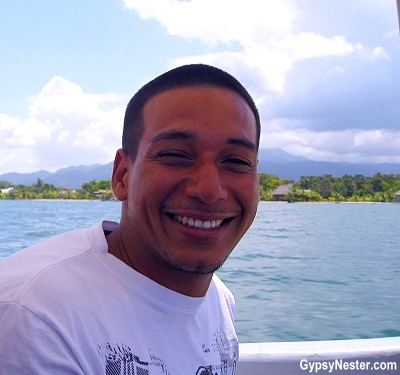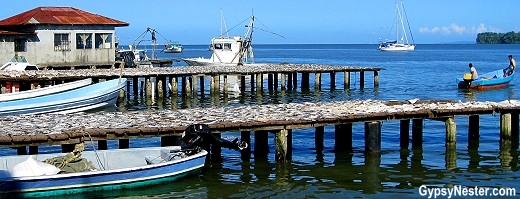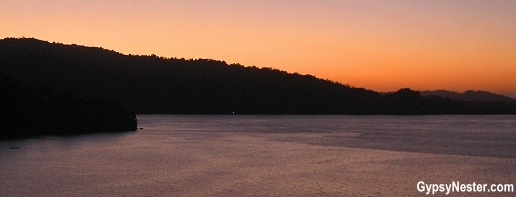
When we heard about Livingston, a tiny outpost on the Guatemalan coast with an intriguing history and only accessible by boat, we knew we had to go.
So, from the busy port of Puerto Barrios we sought passage north.

After some difficulty trying to decipher the schedule and ticketing procedure for the trip, a young man named Salvin came to our aid.
He grew up in Puerto Barrios and had gone to college in Texas, and once he heard our confused English — and poor attempts at Spanish — he jumped in to help us.
Salvin explained that there were no tickets for these small, open ferries. The process is that everybody just climbs on board, hands over fifty Quetzal (about ten dollars), and the skiff leaves whenever it gets full… a boatload so to speak.

We thanked Salvin and stepped aboard, and in no time we were motoring our way across the harbor and up the coast to our destination.
Along the shore, the jungle was so dense that it looked like a solid wall. That and the rugged terrain are what have conspired to keep Livingston so isolated.


Approaching the little town, we still had almost no idea what to expect.
We knew that Livingston has Guatemala’s highest concentration of Garifuna — the descendants of the Carib and Arawak natives — and West Africans who ended up along this coast after multiple trials and tribulations.

In 1635, two Spanish ships carrying Africans to the West Indies for the slave trade shipwrecked near St. Vincent.
The survivors swam ashore and settled among the Carib and Arawak.
Known as Black Caribs, they became the dominant population of St. Vincent until the British invaded in 1763.

Over the following years the Garifuna people were killed and scattered by the British until 1798, when their remnants were exiled to the Island of Roatan off the coast of Honduras.
From Roatan the Garifuna migrated to the mainland of Honduras and settled all along the the Caribbean coast of Belize, Guatemala and Nicaragua.

Hundreds of years later, Livingston’s isolation has created a remarkably untouched example of Garifuna culture.
As we headed up the hill from the docks we took that all in.
We basically had the place to ourselves and the village has an authentic, funky charm that we imagined to be a lot like how the Caribbean islands must have been before they were so developed for tourists.


Livingston is tiny so we were able to walk the main part of it in about an hour.
After topping the hill from the coast and crossing in an open boat, we had had quite a bit of sun and sought shelter in a very cool little inn/restaurant, Hotel Gil, overlooking the bay.
We had noticed it from the boat on our way in and were intrigued how it was built in a stair-step fashion up the side of the steep hill.

When we went inside, no one was there. We walked toward the back and a woman appeared who led us to the restaurant.
We had our own private balcony with tranquil Caribbean views, so we ordered up a couple of the local brews, Gallo.
Gallo is Guatemala’s oldest continually produced beer, dating back to 1896 and by far the most popular beer in the country. It is also the best beer ever made, or maybe it was just the surroundings that made us think so.
Suppose we’ll have to try some in the United States, where it is known as Famosa, to be certain.

Fantastic surroundings and suds aside, the restaurant portion of this establishment left much to be desired, as we had shown up between meal times.
The menu consisted of a few sandwiches from the cooler and some chips. We were dead set on getting some tapado, so we set out to find some.

Tapado is the Garifuna´s signature dish, a seafood soup with an entire fish, shrimp and whatever shellfish was caught lately — soft-shell crab on our particular day — with plantain and/or green bananas in a coconut milk broth spiced with cilantro and a hint of hot peppers.
The hot peppers set off the sweetness of the coconut milk perfectly.

Most of the cafes in town offer it, and Restaurante El Malecon was no exception.
There was the added bonus that El Malecon sits right in the center of town, so we could watch all the goings on from our open air table on the porch.

After just one bite of tapado, we concluded that we had discovered both the best soup and the best beer in the world on the same day.
What are the chances?
But by mid-bowl the entire feel of the town changed drastically.
The tour groups from a cruise ship arrived and suddenly the tiny outpost –including our peaceful restaurant — was overrun with tourists.

On the upside, a traditional Garifuna band was brought in to entertain the invading hoards.
The ensemble consisted of musicians playing several types of rhythm instruments, drums, a turtle shell, conch shell and maracas, while chanting lyrics.
It made for a totally unique sound, and very entertaining.
But as fun they were, there were just too many people, so after a couple of songs we had to bail.
WATCH: A day in Livingston (with highlights of the incredible Garifuna band!)

As we walked off our meal and took in the town, we were struck by the military presence we’d seen.
Livingston, being the sleepy little outpost it was, didn’t seem in need of such heavily armed, fully camouflaged men in uniform.
To us, they stuck out like sore thumbs among the gentle townsfolk. It might be part of everyday life in Guatemala but it was hard for us to get used to the soldiers patrolling streets with automatic rifles.


In an attempt to avoid the crowds, we headed back down the hill toward the docks and noticed a small road leading along the water with only a few Mayan and Garafuna townspeople anywhere to be seen.
This led us to the fishing docks. Actually, the overwhelming smell of fish led us through a tiny alley and we popped out on a dock that was completely covered with fish drying in the sun.


They were making saltfish.
Looking around, every inch of every dock was covered, there were thousands of fish – cleaned, split open, salted, and laid out flat to dry.
The fishermen were hanging around in a dockside watering hole and came out to flip the fish every now and then.
No telling how many centuries this routine has been taking place.


Following the road further, the town soon gave way to the relentless jungle.
We didn’t go all the way to the end — we didn’t have to — we knew the end was not far because there are no roads in or out of Livingston.
Only the only way out was on little boats we came in on. It was at that point we had no clue had no idea when they stopped running.
With sundown fast approaching, that realization had us sadly heading back to the docks.

David & Veronica, GypsyNester.com



Thank you ever so for you article post.Thanks Again. Keep writing.
Howdy! I’m at work browsing your blog from my new iphone!
Just wanted to say I love reading your blog and look forward to all your
posts! Carry on the outstanding work!
Hello. remarkable job. I did not expect this. This is a splendid story. Thanks!
Your internet site has outstanding material. I bookmarked the website
Thanks for the memories. I was in Livingston many years ago (pre-children), and now I am an Empty Nester. It was great fun and culturally rewarding. I had followed the Garifuna trail down from Dangriga, to Punta Gorda, Belize, and over to Livingston, Guatemala. It looks like it has not changed much since that time. Wonderful pictures.
Thanks Judith! Always glad to bring back memories, especially of such a great place.
I have yet to make it to Guatemala, but when I go this little place is going to be on my list. I love smaller, out of the way villages that harken back to a quieter time.
We’re sure you’ll love it!
I love this post and the great shot of tapado soup – one of the best dishes in Guatemala!
Thanks, and the soup rocked!
Hey guys! We are in Belize right now and thinking of heading over to Livingston next Tuesday and taking the boat directly there from Punta Gorda Belize. But we would need to leave on Thursday early morning, therefore only giving us 2 nights and 1 full day. Is it worth the trip? Are we cutting it to short? Couldn’t find the date on this post, when were you guys there? Thanks for any tips!
Absolutely GO! We were completely entranced by Livingston, and it’s small so you can see it all in a day…though it has such a wonderful feel you’ll want to stay longer and just linger. We were there in April of 2011.
Have fun and send pics!
Another fun, informative blog. Again, love to read about your travels.
Thanks! 🙂
I love those travel saviors that stop to help you when you are so clueless. Glad you found Salvin!
So were we!
Wow. You are a spectacular photographer–this town reminds me of the way Yelapa used to be (a small town accessible only by boat from Puerto Vallarta). Wish I could get there right now!!
Thanks, we love sharing our photos.
Great photos – haven’t been to Guatemala yet myself.
Another wonderfully informative travelogue! Thank you so much for sharing.
Another fantastic post transporting me to places I could only ever dream about. I look forward to the next adventure!
Thanks, glad to have you come along with us.
You guys are so very brave. Not only traveling where there’s armed military, but just eating the local foods! 😉 I have been following you on youtube, but I guess I had never run across your website. Thanks for letting this housebound woman in Fargo, North Dakota do some traveling with you. LOL! 🙂
Happy to have you come along with us Rita! 🙂 We always enjoy your comments on YouTube and looking forward to hearing what you have to say here too!